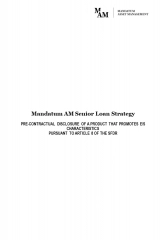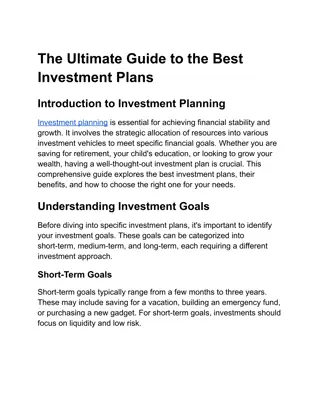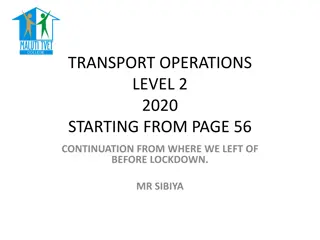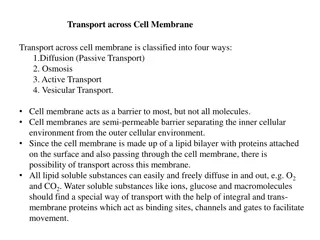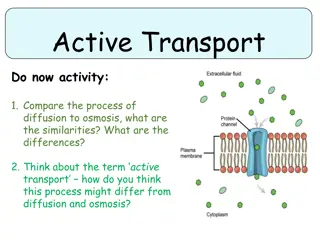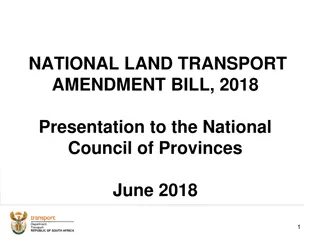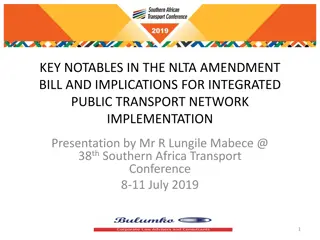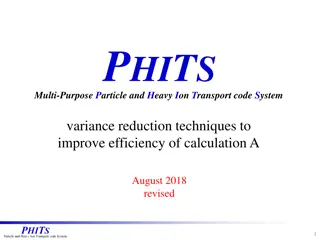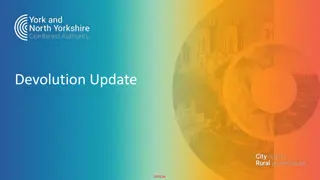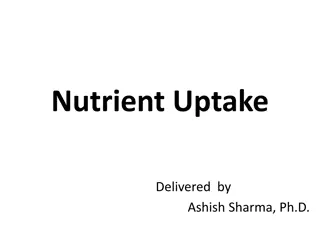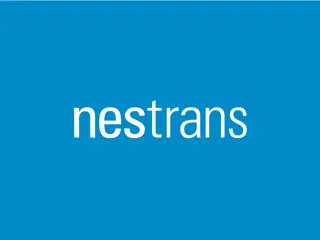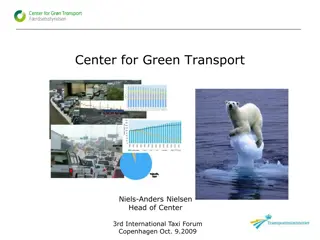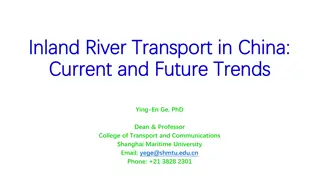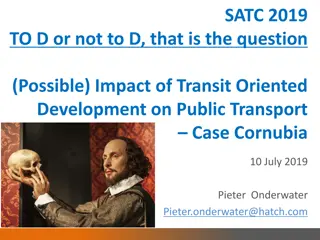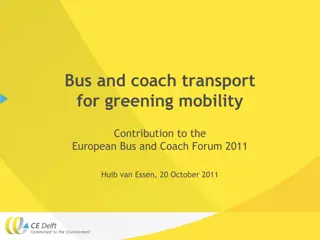Transport Investment Strategy for Improved Efficiency
This content delves into the Spending Review mandate, outlining the goals of making spending more efficient while maintaining current levels, focusing on strategic priorities, investment selection, and governance in the transport sector. The strategy emphasizes a new economic policy approach over traditional modal solutions, emphasizing geographic priorities and efficiency. Challenges, trends, and the need for focused investment to drive economic success are highlighted.
Download Presentation

Please find below an Image/Link to download the presentation.
The content on the website is provided AS IS for your information and personal use only. It may not be sold, licensed, or shared on other websites without obtaining consent from the author.If you encounter any issues during the download, it is possible that the publisher has removed the file from their server.
You are allowed to download the files provided on this website for personal or commercial use, subject to the condition that they are used lawfully. All files are the property of their respective owners.
The content on the website is provided AS IS for your information and personal use only. It may not be sold, licensed, or shared on other websites without obtaining consent from the author.
E N D
Presentation Transcript
Contents 1. Spending Review mandate 2. Improving effectiveness of investment 1. Strategy 2. Investment selection 3. Governance and decision-making 2
Spending Review mandate 1. Outcomes: Make spending more efficient maintain envelope s current size 2. Input costs: 20% savings in operational unit expenditures more efficient performance Expenditures on maintenance and rehabilitation of roads and motorways Subsidizing rail transport 3
Spending Review Priorities IMPROVING EFFECTIVENESS OF SPENDING 4
Strategy Why is Government investing in transport? 5
Getting the Strategy right by asking the right questions in the right context is the first step UK Approach: A new paradigm - an economic policy report, not a transport policy report Focused on fundamental goals, not transport outcomes or inputs (not modes, projects, providers ) No modal chapters and not a wish list of schemes Instead strategic geographic priorities and strategic intervention advice A new blue printfor transport decision-making. 6
How we developed the strategy Future trends Geography and Economy Current network: performance and usage patterns Key challenges and strategic priorities Don t focus on modal solutions or specific projects and notwith we should have one of those too 7
Defining the challenge Issues: Density and concentration of journeys Slide 8 Source: Eddington Transport Study
Defining the challenge Understand how today s patterns play out over time Source: Eddington Transport Study Improve network capacity and performance Focus on cities and international gateways Slide 9
Understand the contribution that transport investment actually makes Transport and economic success Understanding the how helps to drive strategy INDIRECT IMPACT Business efficiency Business investment, innovation Clusters/agglomeration Labour market Competition and trade Globally mobile activity DIRECT IMPACT Cost Time Reliability Quality Comfort Safety User response Transport intervention Increasingly well understood. Very significant in some places and some economies Makes some projects much more worthwhile than others. Well understood and measured Traditionally, the bedrock of cost- benefit analysis. This is why strategy matters Slide 10
Investment selection Improving the effectiveness of investment and intervention 11
Investment selection Meeting the Challenge Implement a new and rigorous policymaking process DEFINE TRUE GOALS 1 What are the nation s economic, environmental and social goals not infrastructure outcomes 2 ASSESS THE MOST PRESSING PROBLEMS Quantify the extent to which different infrastructure problems hinder those goals 3 FOCUS OPTION GENERATION ON THE MOST PRESSING PROBLEMS Focus limited resources on identifying solutions to the most pressing problems 4 LOOK AT THE FULL RANGE OF POSSIBLE SOLUTIONS Don t jump to a favoured project or type of solution, e.g. modal preference or large capital projects 5 USE COST-BENEFIT ANALYSIS TO DRIVE DECISIONS Develop a consistent BCR for all options, and use the data to drive decisions Slide 12
Investment selection Meeting the Challenge What types of interventions offer the best returns? Targeted transport policies offer the prospect of very high returns, even after accounting for environmental and wider welfare impacts But adopt a sophisticated policy mix: Get the prices right across modes fundamental economic principle, as well as critical for combating emissions (NRP = 25bn/yr by 2025, 80% fewer roads) Look at better use measures: longer trains, junctions improvements Small is beautiful, and speculative step change measures unlikely to offer good VFM Measuring all impacts means making different decisions Slide 13
Investment selection The impact Establishing the primacy of economic appraisal Wider Economic Benefits (WEBs) can have a major impact especially in cities Slide 14
The Studys key findings and recommendations Source: Eddington Transport Study Meeting the Challenge Environmental and social effects are highly location specific: Source: Eddington Transport Study Slide 15
Implications for Slovakian policymakers - summary: 1. Could transport policy be better focused on achieving economic, environmental or social goals not transport for transport s sake? 2. Is there a clear strategy and a rigorous policy process, or are things politically driven or project-led? 3. A need for consistent and reliable data to feed into a consistent CBA approach. 4. Is policy too focused on large capital projects at the expense of pricing, regulatory and better use measures? 5. Does policy seek to drive up the returns from investment? Slide 16


